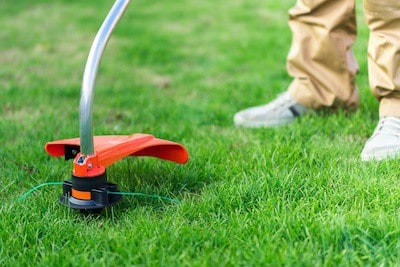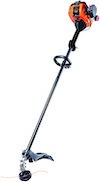Weed Eaters vs. Weed Whackers
What is the correct term for the device used to trim weeds and grasses? A weed eater by any other name–weed whacker, string trimmer, weed trimmer, or weed whipper–is still a weed eater! Even if you’re an Aussie and refer to it as a “whipper snipper.” Weed eaters are an ideal tool for your garden to get into spots too tight for a lawnmower such as around trees, plants, walkways, rocks, or along fences and walls. Trimming these areas in your yard is an effective form of residential pest control.
So, what’s the difference between a weed eater and a weed whacker? The terms are synonymous. The term you prefer to use is more than likely determined by your geographic location in the country. Google Trends shows data about what search terms people use.
- By far the most common internet search term is “weed eater” across the country.
- The highest concentration of searches for “weed eater” come from southern states.
- “String trimmer” is the second-highest search term used, followed by “weed trimmer,” “weed whacker,” and “weed whipper.”
In this post, we will take a look at this handy household tool and the many variations that have been invented over the years.
What is a Weed Eater?
 Weed Eater is the brand name of the very first version of a string trimmer. The company was founded in 1971 in Houston, Texas, by George Ballas, the inventor of the device. Ballas called his invention the “weed eater” for its ability to chew up grass and a lawn full of weeds. The inspiration came to him when he was at a car wash and saw the spinning bristles wrap around his car scrubbing the dirt off.
Weed Eater is the brand name of the very first version of a string trimmer. The company was founded in 1971 in Houston, Texas, by George Ballas, the inventor of the device. Ballas called his invention the “weed eater” for its ability to chew up grass and a lawn full of weeds. The inspiration came to him when he was at a car wash and saw the spinning bristles wrap around his car scrubbing the dirt off.
Due to the popularity of the term “weed eater,” [think Kleenex, Band-Aid, Google, and Xerox], it has become the generic term for this class of products. For this article, we’ll refer to the device as a “weed eater.”
How Are Weed Eaters Used?
Weed eaters are typically used for two tasks:
- Rough areas. When a mower can’t be used due to steep slopes, high grass, bumpy lawns, or rugged terrain, a weed eater provides the power you’ll need to get the job done.
- Post-mowing cleanup. In tight spaces, around fence lines or paths, where a mower isn’t practical, a weed eater offers mobility and ease of use.
Styles of Weed Eaters/Weed Whackers
Weed eaters come in two styles, electric (cordless or corded) trimmers, and gasoline-powered trimmers.
Corded or cordless electric weed eaters are low maintenance because they don’t require gas or oil. They are easy to start and quieter, more lightweight, and economical of the two styles. Cordless models are lighter, have more range than corded ones, and need to be recharged after every use.
Gasoline-powered weed eaters are cordless and can cover a large area. This style is ideal for heavy-duty jobs and brush removal. These types of trimmers come with a wide variety of attachments, such as dual trimmer heads that can cut faster. Gas weed eaters require gas and oil and need to be maintained. They are started using a ripcord pull starter.
Weed eaters with battery packs or gas allow more freedom of movement without being restrained by an extension cord. Electronic models are lighter, cheaper, quieter, and easier to use. Trimmers that are battery-operated won’t last as long as gasoline-powered trimmers.
Electric (Cordless or Corded) Trimmers
Electric trimmers give you intermediate power and use a standard 110-volt socket. With cord lengths of 25-50 feet, they handle thick weeks and high grass.
 Gasoline-Powered Trimmers
Gasoline-Powered Trimmers
Gasoline trimmers supply enough power to trim thick weeds or brush. Since they’re powered by gasoline, they create exhaust and are noisier than electric trimmers.
 Tips for Selecting a Weed Eater
Tips for Selecting a Weed Eater
You’ll find a variety of weed trimming tools on the market with different power sources, shaft styles, handles, and extras. Consider your landscape, how you’ll use the machine, and test out different tools at your local home improvement or hardware store. Think about the distance from electrical outlets–if you have a large lot and need to remove weeds at the far edge of the property, an electric trimmer won’t work so far from your outlets.
Compare motor sizes and compare features when selecting a weed eater. Manufacturers rate electric weed trimmers according to amperage (amp) or volts (v). Amperage and volts represent the power the trimmer produces–the higher the amperage or volts, the faster the trimmer.
Features range from auto-shutoff release triggers and extended safety guard around the trimming cord, to sure-grip handles, push-button start, and deep cord basins to store extra trimming cord. Review the extra features on each weed eater model. For example, some trimmers handle edging, allowing clean lines along the edges of sidewalks and driveways.
Other models come with a guard to protect plants in the garden that you don’t want to be trimmed. Another option, such as a see-through gas tank, is available so you know when it’s time to refill the tank with gas.
Other Considerations
Other factors to consider when choosing a string trimmer are the size of your yard and the obstacles in your landscaping. In a smaller yard, you can get by with a less expensive electric trimmer. If your yard is larger, you’ll want a battery or gas trimmer. If you have many trees, poles, walkways, or fences, one of these cordless trimmers will provide better flexibility without having to deal with a tangled cord. Larger yards might be best served using a gasoline-powered machine since it offers a longer trimming time.
Maintaining Your Weed Eater
When performing string trimmer maintenance, first be sure it’s turned off. For gasoline-powered trimmers, remove the spark plug when making any repairs. Additionally, using the right trimmer line goes a long way to make your trimmer work efficiently. A standard-grade line is economical and best suited for low-intensity trimming. A commercial-grade line is best used with heavy-duty gas trimmers.
Replacing Your Weed Eater String
When your string line breaks or wears down, you need to replace it. To replace the string follow these steps:
- Remove the spool from the trimmer’s head and cut a new piece of string about 8-feet long.
- Feed one end of the string through the spool’s holes, then pull on it to make sure the ends are even.
- The spool should have an arrow printed on it to show you the direction to wind the string. Following the arrow, begin to wind the string around the spool.
- Secure the ends of the string into the notches on the spool and return the spool to the trimmer.
- Feed the ends of the string through the holes in the head and tug on each string to release it from the notches. If your trimmer has a self-winding head, feed the length of the string through the spool and rotate the head to wind the string.
PRO TIP: When you change the string, check the trimmer for any damage and clean up the machine.
Tips for Starting a Weed Eater
A gas weed eater starts like a car or other gas-powered vehicle. An electric weed eater operates similarly to electric home appliances.
For gasoline-powered weed eaters, follow these steps:
- Make sure the gas tank is sealed before starting it. Check the gas tank for the right gas mixture–most weed eaters are two-cycle.
- Flip the kill switch (also known as the on/off switch) on. The kill switch controls the flow of electricity to the motor. When it’s off, the engine can’t start.
- Switch the choke to the “on” or “closed” position if you’re starting the trimmer cold. A cold start refers to any time you start an engine when its temperature is colder than the temperature it typically runs at. The choke will restrict the airflow into the engine which makes it easier to start.
- Push the primer bulb five to six times (or more if your weed eater hasn’t been used for a while). Pushing the valve gets more gas to the carburetor.
- Hold the throttle lock and pull the rope to start the engine. Once you hear the motor, stop pulling. The engine will die down after a few seconds.
- Turn off the choke to avoid wasting fuel.
For electric weed eaters:
Electric weed eaters start as soon as they have power.
- Corded: Plug the male end of the cord into a wall outlet. Once plugged in, the weed eater has power and is ready to be turned on.
- Cordless: Once the battery is charged and attached to the weed eater, push the on button or flip the on/off switch to the on position.
Weed Eater Safety Tips
- Use the line size recommended by the manufacturer. A heavier line puts extra stress on the motor.
- Some models have a tap line feature, which is a button on the bottom of the head that lets out extra line when you tap it on the ground.
- Some advanced trimmers have automatic line-advance systems that sense when the line is worn and will automatically release more.
- Always wear safety goggles to protect your eyes from flying debris.
- Wear boots or sturdy shoes to protect your feet.
- Gloves are recommended while operating your trimmer, especially if vibrations bother you or your hands tend to blister.
Thanks for reading! You can find more lawn care tips here.



